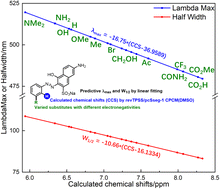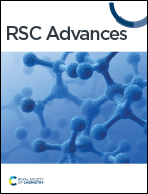Study of the electronic effect and quantitative spectra predictions of o-methoxyaniline-terminated monoazonaphthols: a combined experimental and DFT study†
Abstract
A combined experimental and density functional theory (DFT) study on the UV-Vis spectra of o-methoxyaniline-terminated mono azo dyes was conducted. By applying time-dependent-DFT calculations, details of excitation processes were determined and visualization by hole–electron analysis was undertaken. Fragment-divided analysis revealed the contributions of different parts of the structures for the UV-Vis spectra, that richer/poorer electron density on aromatic rings lead to greater/less maximum absorption wavelengths (λmax) and larger/smaller half peak width (W1/2). Combining theoretical prediction with experimental verification, we answered the question of how the electronegativities of substituents affected the electron densities and how it affected the spectra. In addition, a linear model connecting the λmax and W1/2 to the chemical shifts obtained by NMR spectroscopy was constructed, which laid the foundation for construction of a spectral library.



 Please wait while we load your content...
Please wait while we load your content...